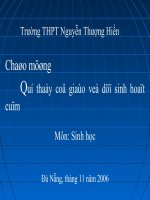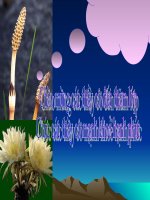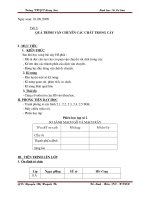Campbel 7 TB va van chuyen cac chat
Bạn đang xem bản rút gọn của tài liệu. Xem và tải ngay bản đầy đủ của tài liệu tại đây (5.86 MB, 83 trang )
<span class='text_page_counter'>(1)</span><div class='page_container' data-page=1>
Copyright © 2008 Pearson Education, Inc., publishing as Pearson Benjamin Cummings
<b>PowerPoint®<sub> Lecture </sub></b>
<b>Presentations for</b>
<b>Biology</b>
<i><b>Eighth Edition</b></i>
<b>Neil Campbell and Jane Reece</b>
<b>Lectures by Chris Romero, updated by Erin Barley with contributions from Joan Sharp</b>
<b>Chapter 7</b>
<b>Chapter 7</b>
</div>
<span class='text_page_counter'>(2)</span><div class='page_container' data-page=2>
• <sub>The plasma membrane is the boundary that </sub>
separates the living cell from its surroundings
• The plasma membrane exhibits <b>selective </b>
<b>permeability</b>, allowing some substances to
cross it more easily than others
</div>
<span class='text_page_counter'>(3)</span><div class='page_container' data-page=3></div>
<span class='text_page_counter'>(4)</span><div class='page_container' data-page=4>
<b>of lipids and proteins</b>
• <sub>Phospholipids are the most abundant lipid in </sub>
the plasma membrane
• <sub>Phospholipids are </sub><b><sub>amphipathic</sub></b> <b><sub>molecules</sub></b><sub>, </sub>
containing hydrophobic and hydrophilic regions
• The <b>fluid mosaic model </b>states that a
membrane is a fluid structure with a “mosaic” of
various proteins embedded in it
</div>
<span class='text_page_counter'>(5)</span><div class='page_container' data-page=5>
<b>Membrane Models: </b><i><b>Scientific Inquiry</b></i>
• <sub>Membranes have been chemically analyzed </sub>
and found to be made of proteins and lipids
• Scientists studying the plasma membrane
reasoned that it must be a phospholipid bilayer
</div>
<span class='text_page_counter'>(6)</span><div class='page_container' data-page=6>
<b>Hydrophilic</b>
<b>head</b>
<b>WATER</b>
<b>Hydrophobic</b>
<b>tail</b>
</div>
<span class='text_page_counter'>(7)</span><div class='page_container' data-page=7>
• In 1935, Hugh Davson and James Danielli
proposed a sandwich model in which the
phospholipid bilayer lies between two layers of
globular proteins
• Later studies found problems with this model,
particularly the placement of membrane proteins,
which have hydrophilic and hydrophobic regions
• In 1972, J. Singer and G. Nicolson proposed that
the membrane is a mosaic of proteins dispersed
within the bilayer, with only the hydrophilic regions
exposed to water
</div>
<span class='text_page_counter'>(8)</span><div class='page_container' data-page=8>
<b>Phospholipid</b>
<b>bilayer</b>
<b>Hydrophobic regions</b>
</div>
<span class='text_page_counter'>(9)</span><div class='page_container' data-page=9>
• <sub>Freeze-fracture studies of the plasma </sub>
membrane supported the fluid mosaic model
• Freeze-fracture is a specialized preparation
technique that splits a membrane along the
middle of the phospholipid bilayer
</div>
<span class='text_page_counter'>(10)</span><div class='page_container' data-page=10>
<b>TECHNIQUE</b>
<b>Extracellular</b>
<b>layer</b>
<b>Knife</b> <b>Proteins Inside of extracellular layer</b>
<b>RESULTS</b>
<b>Inside of cytoplasmic layer</b>
<b>Cytoplasmic layer</b>
</div>
<span class='text_page_counter'>(11)</span><div class='page_container' data-page=11>
<b>The Fluidity of Membranes</b>
• <sub>Phospholipids in the plasma membrane can </sub>
move within the bilayer
• <sub>Most of the lipids, and some proteins, drift </sub>
laterally
• Rarely does a molecule flip-flop transversely
across the membrane
</div>
<span class='text_page_counter'>(12)</span><div class='page_container' data-page=12>
<b>Lateral movement</b>
<b>(~107<sub> times per second)</sub></b>
<b>Flip-flop</b>
<b>(~ once per month)</b>
<b>(a) Movement of phospholipids</b>
<b>(b) Membrane fluidity</b>
<b>Fluid</b> <b>Viscous</b>
<b>Unsaturated hydrocarbon</b>
<b>tails with kinks</b> <b>Saturated hydro-carbon tails</b>
</div>
<span class='text_page_counter'>(13)</span><div class='page_container' data-page=13>
Fig. 7-5a
<b>(a) Movement of phospholipids</b>
<b>Lateral movement</b>
<b>(</b><b>107 times per </b>
<b>second)</b>
<b>Flip-flop</b>
</div>
<span class='text_page_counter'>(14)</span><div class='page_container' data-page=14>
<b>RESULTS</b>
<b>Membrane proteins</b>
<b>Mouse cell</b>
<b>Human cell</b>
<b>Hybrid cell</b>
</div>
<span class='text_page_counter'>(15)</span><div class='page_container' data-page=15>
• As temperatures cool, membranes switch from
a fluid state to a solid state
• <sub>The temperature at which a membrane </sub>
solidifies depends on the types of lipids
• Membranes rich in unsaturated fatty acids are
more fluid that those rich in saturated fatty
acids
• <sub>Membranes must be fluid to work properly; </sub>
they are usually about as fluid as salad oil
</div>
<span class='text_page_counter'>(16)</span><div class='page_container' data-page=16>
<b>(b) Membrane fluidity</b>
<b>Fluid</b>
<b>Unsaturated hydrocarbon</b>
<b>tails with kinks</b>
<b>Viscous</b>
</div>
<span class='text_page_counter'>(17)</span><div class='page_container' data-page=17>
• <sub>The steroid cholesterol has different effects on </sub>
membrane fluidity at different temperatures
• <sub>At warm temperatures (such as 37°C), </sub>
cholesterol restrains movement of
phospholipids
• At cool temperatures, it maintains fluidity by
preventing tight packing
</div>
<span class='text_page_counter'>(18)</span><div class='page_container' data-page=18>
<b>Cholesterol</b>
</div>
<span class='text_page_counter'>(19)</span><div class='page_container' data-page=19>
<b>Membrane Proteins and Their Functions</b>
• <sub>A membrane is a collage of different proteins </sub>
embedded in the fluid matrix of the lipid bilayer
• <sub>Proteins determine most of the membrane’s </sub>
specific functions
</div>
<span class='text_page_counter'>(20)</span><div class='page_container' data-page=20></div>
<span class='text_page_counter'>(21)</span><div class='page_container' data-page=21>
• <b>Peripheral proteins </b>are bound to the surface
of the membrane
• <b><sub>Integral proteins </sub></b><sub>penetrate the hydrophobic </sub>
core
• Integral proteins that span the membrane are
called transmembrane proteins
• <sub>The hydrophobic regions of an integral protein </sub>
consist of one or more stretches of nonpolar
amino acids, often coiled into alpha helices
</div>
<span class='text_page_counter'>(22)</span><div class='page_container' data-page=22>
<b>N-terminus</b>
<b>C-terminus</b>
<b> Helix</b>
<b>CYTOPLASMIC</b>
<b>SIDE</b>
</div>
<span class='text_page_counter'>(23)</span><div class='page_container' data-page=23>
• <sub>Six major functions of membrane proteins:</sub>
– <sub>Transport</sub>
– <sub>Enzymatic activity</sub>
– <sub>Signal transduction</sub>
– <sub>Cell-cell recognition</sub>
– <sub>Intercellular joining</sub>
– <sub>Attachment to the cytoskeleton and </sub>
extracellular matrix (ECM)
</div>
<span class='text_page_counter'>(24)</span><div class='page_container' data-page=24>
<b>(a) Transport</b>
<b>ATP</b>
<b>(b) Enzymatic activity</b>
<b>Enzymes</b>
<b>(c) Signal transduction</b>
<b>Signal transduction</b>
<b>Receptor</b>
<b>(d) Cell-cell recognition</b>
<b></b>
<b>Glyco-protein</b>
</div>
<span class='text_page_counter'>(25)</span><div class='page_container' data-page=25>
Fig. 7-9ac
<b>(a) Transport</b> <b>(b) Enzymatic activity</b> <b>(c) Signal transduction</b>
<b>ATP</b>
<b>Enzymes</b>
<b>Signal transduction</b>
<b>Signaling molecule</b>
</div>
<span class='text_page_counter'>(26)</span><div class='page_container' data-page=26>
<b>(d) Cell-cell recognition</b>
<b></b>
<b>Glyco-protein</b>
</div>
<span class='text_page_counter'>(27)</span><div class='page_container' data-page=27>
<b>The Role of Membrane Carbohydrates in Cell-Cell </b>
<b>Recognition</b>
• <sub>Cells recognize each other by binding to </sub>
surface molecules, often carbohydrates, on the
plasma membrane
• Membrane carbohydrates may be covalently
bonded to lipids (forming <b>glycolipids</b>) or more
commonly to proteins (forming <b>glycoproteins</b>)
• Carbohydrates on the external side of the
plasma membrane vary among species,
individuals, and even cell types in an individual
</div>
<span class='text_page_counter'>(28)</span><div class='page_container' data-page=28>
• <sub>Membranes have distinct inside and outside </sub>
faces
• <sub>The asymmetrical distribution of proteins, </sub>
lipids, and associated carbohydrates in the
plasma membrane is determined when the
membrane is built by the ER and Golgi
apparatus
</div>
<span class='text_page_counter'>(29)</span><div class='page_container' data-page=29></div>
<span class='text_page_counter'>(30)</span><div class='page_container' data-page=30>
<b>selective permeability</b>
• <sub>A cell must exchange materials with its </sub>
surroundings, a process controlled by the
plasma membrane
• Plasma membranes are selectively permeable,
regulating the cell’s molecular traffic
</div>
<span class='text_page_counter'>(31)</span><div class='page_container' data-page=31>
<b>The Permeability of the Lipid Bilayer</b>
• <sub>Hydrophobic (nonpolar) molecules, such as </sub>
hydrocarbons, can dissolve in the lipid bilayer
and pass through the membrane rapidly
• Polar molecules, such as sugars, do not cross
the membrane easily
</div>
<span class='text_page_counter'>(32)</span><div class='page_container' data-page=32>
• <b><sub>Transport proteins </sub></b><sub>allow passage of </sub>
hydrophilic substances across the membrane
• <sub>Some transport proteins, called</sub> <sub>channel </sub>
proteins, have a hydrophilic channel that
certain molecules or ions can use as a tunnel
• Channel proteins called <b>aquaporins </b>facilitate
the passage of water
</div>
<span class='text_page_counter'>(33)</span><div class='page_container' data-page=33>
• <sub>Other transport proteins, called </sub><i><sub>carrier proteins</sub></i><sub>, </sub>
bind to molecules and change shape to shuttle
them across the membrane
• A transport protein is specific for the substance
it moves
</div>
<span class='text_page_counter'>(34)</span><div class='page_container' data-page=34>
<b>substance across a membrane with no energy </b>
<b>investment</b>
• <b><sub>Diffusion </sub></b><sub>is the tendency for molecules to </sub>
spread out evenly into the available space
• <sub>Although each molecule moves randomly, </sub>
diffusion of a population of molecules may
exhibit a net movement in one direction
• At dynamic equilibrium, as many molecules
cross one way as cross in the other direction
<b>Animation: Membrane Selectivity</b>
<b>Animation: Membrane Selectivity</b> <b>Animation: DiffusionAnimation: Diffusion</b>
</div>
<span class='text_page_counter'>(35)</span><div class='page_container' data-page=35>
Fig. 7-11
<b>Molecules of dye</b> <b><sub>Membrane (cross section)</sub></b>
<b>WATER</b>
<b>Net diffusion</b> <b>Net diffusion</b> <b>Equilibrium</b>
<b>(a) Diffusion of one solute</b>
<b>Net diffusion</b>
<b>Net diffusion</b>
<b>Net diffusion</b>
<b>Net diffusion</b>
<b>Equilibrium</b>
<b>Equilibrium</b>
</div>
<span class='text_page_counter'>(36)</span><div class='page_container' data-page=36>
<b>Molecules of dye</b> <b>Membrane (cross section)</b>
<b>WATER</b>
<b>Net diffusion</b> <b>Net diffusion</b>
<b>(a) Diffusion of one solute</b>
</div>
<span class='text_page_counter'>(37)</span><div class='page_container' data-page=37>
• <sub>Substances diffuse down their </sub><b><sub>concentration </sub></b>
<b>gradient</b>, the difference in concentration of a
substance from one area to another
• <sub>No work must be done to move substances </sub>
down the concentration gradient
• The diffusion of a substance across a biological
membrane is <b>passive transport </b>because it
requires no energy from the cell to make it
happen
</div>
<span class='text_page_counter'>(38)</span><div class='page_container' data-page=38>
<b>(b) Diffusion of two solutes</b>
<b>Net diffusion</b>
<b>Net diffusion</b>
<b>Net diffusion</b>
<b>Net diffusion</b>
</div>
<span class='text_page_counter'>(39)</span><div class='page_container' data-page=39>
<b>Effects of Osmosis on Water Balance</b>
• <b><sub>Osmosis </sub></b><sub>is the diffusion of water across a </sub>
selectively permeable membrane
• Water diffuses across a membrane from the
region of lower solute concentration to the
region of higher solute concentration
</div>
<span class='text_page_counter'>(40)</span><div class='page_container' data-page=40>
<b>of solute (sugar)</b>
<b>H<sub>2</sub>O</b>
<b>of sugar</b>
<b>Selectively</b>
<b>permeable</b>
<b>membrane</b>
</div>
<span class='text_page_counter'>(41)</span><div class='page_container' data-page=41>
<i><b>Water Balance of Cells Without Walls</b></i>
• <b><sub>Tonicity </sub></b><sub>is the ability of a solution to cause a </sub>
cell to gain or lose water
• <b><sub>Isotonic </sub></b><sub>solution: Solute concentration is the </sub>
same as that inside the cell; no net water
movement across the plasma membrane
• <b><sub>Hypertonic </sub></b><sub>solution: Solute concentration is </sub>
greater than that inside the cell; cell loses
water
• <b>Hypotonic </b>solution: Solute concentration is
less than that inside the cell; cell gains water
</div>
<span class='text_page_counter'>(42)</span><div class='page_container' data-page=42>
<b>Hypotonic solution</b>
<b>(a) Animal</b>
<b> cell</b>
<b>(b) Plant</b>
<b> cell</b>
<b>H<sub>2</sub>O</b>
<b>Lysed</b>
<b>H<sub>2</sub>O</b>
<b>Turgid (normal)</b>
<b>H<sub>2</sub>O</b>
<b>H<sub>2</sub>O</b>
<b>H<sub>2</sub>O</b>
<b>H<sub>2</sub>O</b>
<b>Normal</b>
<b>Isotonic solution</b>
<b>Flaccid</b>
<b>H<sub>2</sub>O</b>
<b>H<sub>2</sub>O</b>
<b>Shriveled</b>
</div>
<span class='text_page_counter'>(43)</span><div class='page_container' data-page=43>
• <sub>Hypertonic or hypotonic environments create </sub>
osmotic problems for organisms
• <b><sub>Osmoregulation</sub></b><sub>, the control of water balance, </sub>
is a necessary adaptation for life in such
environments
• The protist <i>Paramecium,</i> which is hypertonic to
its pond water environment, has a contractile
vacuole that acts as a pump
<b>Video: </b>
</div>
<span class='text_page_counter'>(44)</span><div class='page_container' data-page=44>
<b>(a) A contractile vacuole fills with fluid that enters from</b>
<b> a system of canals radiating throughout the cytoplasm.</b>
<b>Contracting vacuole </b>
</div>
<span class='text_page_counter'>(45)</span><div class='page_container' data-page=45>
<i><b>Water Balance of Cells with Walls</b></i>
• <sub>Cell walls help maintain water balance</sub>
• A plant cell in a hypotonic solution swells until
the wall opposes uptake; the cell is now <b>turgid</b>
(firm)
• <sub>If a plant cell and its surroundings are isotonic, </sub>
there is no net movement of water into the cell;
the cell becomes <b>flaccid </b>(limp), and the plant
may wilt
</div>
<span class='text_page_counter'>(46)</span><div class='page_container' data-page=46>
<b>Video: Plasmolysis</b>
<b>Video: Plasmolysis</b>
<b>Video: Turgid </b>
<b>Video: Turgid </b><i><b>Elodea</b><b>Elodea</b></i>
<b>Animation: Osmosis</b>
<b>Animation: Osmosis</b>
water; eventually, the membrane pulls away
from the wall, a usually lethal effect called
<b>plasmolysis</b>
</div>
<span class='text_page_counter'>(47)</span><div class='page_container' data-page=47>
<b>Facilitated Diffusion: Passive Transport Aided by </b>
<b>Proteins</b>
• <sub>In </sub><b><sub>facilitated diffusion</sub></b><sub>, transport proteins </sub>
speed the passive movement of molecules
across the plasma membrane
• <sub>Channel proteins provide corridors that allow a </sub>
specific molecule or ion to cross the membrane
• Channel proteins include
– <sub>Aquaporins, for facilitated diffusion of water</sub>
– <b><sub>Ion channels </sub></b><sub>that open or close in response </sub>
to a stimulus (<b>gated channels</b>)
</div>
<span class='text_page_counter'>(48)</span><div class='page_container' data-page=48>
<b>FLUID </b>
<b>Channel protein </b>
<b>(a) A channel protein </b>
<b>Solute </b>
<b>CYTOPLASM </b>
<b>Solute </b>
<b>Carrier protein </b>
</div>
<span class='text_page_counter'>(49)</span><div class='page_container' data-page=49>
• Carrier proteins undergo a subtle change in
shape that translocates the solute-binding site
across the membrane
</div>
<span class='text_page_counter'>(50)</span><div class='page_container' data-page=50>
specific transport systems, for example the
kidney disease cystinuria
</div>
<span class='text_page_counter'>(51)</span><div class='page_container' data-page=51>
<b>Concept 7.4: Active transport uses energy to move </b>
<b>solutes against their gradients</b>
• <sub>Facilitated diffusion is still passive because the </sub>
solute moves down its concentration gradient
• Some transport proteins, however, can move
solutes against their concentration gradients
</div>
<span class='text_page_counter'>(52)</span><div class='page_container' data-page=52>
• <b><sub>Active transport </sub></b><sub>moves substances against </sub>
their concentration gradient
• <sub>Active transport requires energy, usually in the </sub>
form of ATP
• Active transport is performed by specific
proteins embedded in the membranes
<b>Animation: Active Transport</b>
</div>
<span class='text_page_counter'>(53)</span><div class='page_container' data-page=53>
• <sub>Active transport allows cells to maintain </sub>
concentration gradients that differ from their
surroundings
• The <b>sodium-potassium pump </b>is one type of
active transport system
</div>
<span class='text_page_counter'>(54)</span><div class='page_container' data-page=54>
<b>EXTRACELLULAR</b>
<b>FLUID </b> <b>[Na</b>
<b>+] high </b>
<b>[K+] low </b>
<b>Na+</b>
<b>Na+</b>
<b>Na+</b> <b>[Na</b>
<b>+<sub>] low</sub></b>
<b>[K+<sub>] high </sub></b>
<b>CYTOPLASM </b>
<b> Cytoplasmic Na+ binds to</b>
<b>the sodium-potassium pump.</b>
</div>
<span class='text_page_counter'>(55)</span><div class='page_container' data-page=55>
<b> Na+ binding stimulates</b>
<b>phosphorylation by ATP. </b>
Fig. 7-16-2
<b>Na+</b>
<b>Na+</b>
<b>Na+</b>
<b>ATP </b>
<b>P </b>
<b>ADP </b>
</div>
<span class='text_page_counter'>(56)</span><div class='page_container' data-page=56>
<b> Phosphorylation causes</b>
<b>the protein to change its</b>
<b>shape. Na+ is expelled to</b>
<b>the outside. </b>
<b>Na+</b>
<b>P </b>
<b>Na+</b>
<b>Na+</b>
</div>
<span class='text_page_counter'>(57)</span><div class='page_container' data-page=57>
Fig. 7-16-4
<b> K+ binds on the</b>
<b>extracellular side and</b>
<b>triggers release of the</b>
<b>phosphate group. </b>
<b>P</b>
<b>P</b>
<b>K+</b>
<b>K+</b>
</div>
<span class='text_page_counter'>(58)</span><div class='page_container' data-page=58>
<b> Loss of the phosphate</b>
<b>restores the protein’s original</b>
<b>shape. </b>
<b>K+</b>
<b>K+</b>
</div>
<span class='text_page_counter'>(59)</span><div class='page_container' data-page=59>
Fig. 7-16-6
<b> K+ is released, and the</b>
<b>cycle repeats. </b>
<b>K+</b>
<b>K+</b>
</div>
<span class='text_page_counter'>(60)</span><div class='page_container' data-page=60>
<b>2</b>
<b>FLUID</b> <b>[K+<sub>] low</sub></b>
<b>[Na+<sub>] low </sub></b>
<b>[K+<sub>] high</sub></b>
</div>
<span class='text_page_counter'>(61)</span><div class='page_container' data-page=61>
Fig. 7-17
<b>Passive transport </b>
<b>Diffusion </b> <b>Facilitated diffusion </b>
<b>Active transport </b>
</div>
<span class='text_page_counter'>(62)</span><div class='page_container' data-page=62>
• <b><sub>Membrane potential </sub></b><sub>is the voltage difference </sub>
across a membrane
• Voltage is created by differences in the
distribution of positive and negative ions
</div>
<span class='text_page_counter'>(63)</span><div class='page_container' data-page=63>
• Two combined forces, collectively called the
<b>electrochemical gradient</b>, drive the diffusion
of ions across a membrane:
– <sub>A chemical force (the ion’s concentration </sub>
gradient)
– <sub>An electrical force (the effect of the membrane </sub>
potential on the ion’s movement)
</div>
<span class='text_page_counter'>(64)</span><div class='page_container' data-page=64>
that generates voltage across a membrane
• <sub>The sodium-potassium pump is the major </sub>
electrogenic pump of animal cells
• The main electrogenic pump of plants, fungi,
and bacteria is a <b>proton pump</b>
</div>
<span class='text_page_counter'>(65)</span><div class='page_container' data-page=65></div>
<span class='text_page_counter'>(66)</span><div class='page_container' data-page=66>
<b>Protein</b>
• <b><sub>Cotransport </sub></b><sub>occurs when active transport of a </sub>
solute indirectly drives transport of another
solute
• Plants commonly use the gradient of hydrogen
ions generated by proton pumps to drive active
transport of nutrients into the cell
</div>
<span class='text_page_counter'>(67)</span><div class='page_container' data-page=67>
Fig. 7-19
<b>Proton pump </b>
<b>– </b>
<b>– </b>
<b>– </b>
<b>– </b>
<b>– </b>
<b>– </b>
<b>+</b>
<b>+</b>
<b>+</b>
<b>+</b>
<b>+</b>
<b>+</b>
<b>ATP</b>
<b>H+</b>
<b>H+</b>
<b>H+</b>
<b>H+</b>
<b>H+</b>
<b>H+</b>
<b>H+</b>
<b>H+</b>
<b>Diffusion</b>
<b>of H+</b>
<b>Sucrose-H+</b>
<b>cotransporter </b>
<b>Sucrose </b>
</div>
<span class='text_page_counter'>(68)</span><div class='page_container' data-page=68>
<b>membrane occurs by exocytosis and endocytosis</b>
• Small molecules and water enter or leave the
cell through the lipid bilayer or by transport
proteins
• Large molecules, such as polysaccharides and
proteins, cross the membrane in bulk via
vesicles
• <sub>Bulk transport requires energy</sub>
</div>
<span class='text_page_counter'>(69)</span><div class='page_container' data-page=69>
<b>Exocytosis</b>
• <sub>In </sub><b><sub>exocytosis</sub></b><sub>, transport vesicles migrate to the </sub>
membrane, fuse with it, and release their
contents
• Many secretory cells use exocytosis to export
their products
<b>Animation: Exocytosis</b>
</div>
<span class='text_page_counter'>(70)</span><div class='page_container' data-page=70>
• In <b>endocytosis</b>, the cell takes in macromolecules
by forming vesicles from the plasma membrane
• Endocytosis is a reversal of exocytosis, involving
different proteins
• There are three types of endocytosis:
– <sub>Phagocytosis (“cellular eating”)</sub>
– <sub>Pinocytosis (“cellular drinking”)</sub>
– <sub>Receptor-mediated endocytosis</sub>
<b>Animation: Exocytosis and Endocytosis Introduction</b>
</div>
<span class='text_page_counter'>(71)</span><div class='page_container' data-page=71>
• <sub>In </sub><b><sub>phagocytosis </sub></b><sub>a cell engulfs a particle in a </sub>
vacuole
• <sub>The vacuole fuses with a lysosome to digest </sub>
the particle
<b>Animation: Phagocytosis</b>
<b>Animation: Phagocytosis</b>
</div>
<span class='text_page_counter'>(72)</span><div class='page_container' data-page=72>
<b>“Food”or</b>
<b>other particle</b>
<b>Food</b>
<b>vacuole </b>
<b>PINOCYTOSIS </b>
<b>Pseudopodium</b>
<b>of amoeba </b>
<b>Bacterium </b>
<b>Food vacuole </b>
<b>An amoeba engulfing a bacterium</b>
<b>via phagocytosis (TEM) </b>
<b>Plasma</b>
<b>membrane </b>
<b>Vesicle </b>
<b>0.5 µm </b>
<b>Pinocytosis vesicles</b>
<b>forming (arrows) in</b>
<b>a cell lining a small</b>
<b>blood vessel (TEM) </b>
<b>RECEPTOR-MEDIATED ENDOCYTOSIS </b>
<b>Receptor </b>
<b>Coat protein </b>
<b>Coated</b>
<b>vesicle </b>
<b>Coated</b>
<b>pit </b>
<b>Ligand </b>
<b>Coat</b>
<b>protein </b>
<b>Plasma</b>
<b>membrane </b>
</div>
<span class='text_page_counter'>(73)</span><div class='page_container' data-page=73>
Fig. 7-20a
<b>PHAGOCYTOSIS </b>
<b>CYTOPLASM </b>
<b>EXTRACELLULAR</b>
<b>FLUID </b>
<b>Pseudopodium </b>
<b>“Food” or</b>
<b>other particle </b>
<b>Food</b>
<b>vacuole </b> <b><sub>Food vacuole </sub></b>
<b>Bacterium </b>
<b>An amoeba engulfing a bacterium</b>
<b>via phagocytosis (TEM) </b>
<b>Pseudopodium</b>
<b>of amoeba </b>
</div>
<span class='text_page_counter'>(74)</span><div class='page_container' data-page=74>
extracellular fluid is “gulped” into tiny vesicles
<b>Animation: Pinocytosis</b>
<b>Animation: Pinocytosis</b>
</div>
<span class='text_page_counter'>(75)</span><div class='page_container' data-page=75>
Fig. 7-20b
<b>PINOCYTOSIS </b>
<b>Plasma</b>
<b>membrane </b>
<b>Vesicle </b>
<b>0.5 µm </b>
</div>
<span class='text_page_counter'>(76)</span><div class='page_container' data-page=76>
• In <b>receptor-mediated endocytosis</b>, binding of
ligands to receptors triggers vesicle formation
• <sub>A </sub><b><sub>ligand </sub></b><sub>is any molecule that binds specifically </sub>
to a receptor site of another molecule
<b>Animation: Receptor-Mediated Endocytosis</b>
<b>Animation: Receptor-Mediated Endocytosis</b>
</div>
<span class='text_page_counter'>(77)</span><div class='page_container' data-page=77>
Fig. 7-20c
<b>RECEPTOR-MEDIATED ENDOCYTOSIS </b>
<b>Receptor </b>
<b>Coat protein </b>
<b>Coated</b>
<b>pit</b>
<b>Ligand</b>
<b>Coat</b>
<b>protein</b>
<b>Plasma</b>
<b>membrane</b>
<b>0.25 µm </b>
<b>Coated</b>
<b>vesicle</b>
</div>
<span class='text_page_counter'>(78)</span><div class='page_container' data-page=78>
<b>Facilitated diffusion </b>
<b>Channel</b>
<b>protein </b>
</div>
<span class='text_page_counter'>(79)</span><div class='page_container' data-page=79>
Fig. 7-UN2
<b>Active transport: </b>
</div>
<span class='text_page_counter'>(80)</span><div class='page_container' data-page=80>
<b>Environment:</b>
<b>0.01 </b><i><b>M</b></i><b> sucrose</b>
<b>0.01 </b><i><b>M</b></i><b> glucose</b>
<b>0.01 </b><i><b>M</b></i><b> fructose </b>
<b>“Cell” </b>
<b>0.03 </b><i><b>M</b></i><b> sucrose</b>
</div>
<span class='text_page_counter'>(81)</span><div class='page_container' data-page=81></div>
<span class='text_page_counter'>(82)</span><div class='page_container' data-page=82>
1. Define the following terms: amphipathic
molecules, aquaporins, diffusion
2. Explain how membrane fluidity is influenced
by temperature and membrane composition
3. Distinguish between the following pairs or
sets of terms: peripheral and integral
membrane proteins; channel and carrier
proteins; osmosis, facilitated diffusion, and
active transport; hypertonic, hypotonic, and
isotonic solutions
</div>
<span class='text_page_counter'>(83)</span><div class='page_container' data-page=83>
4. Explain how transport proteins facilitate
diffusion
5. Explain how an electrogenic pump creates
voltage across a membrane, and name two
electrogenic pumps
6. Explain how large molecules are transported
across a cell membrane
</div>
<!--links-->









